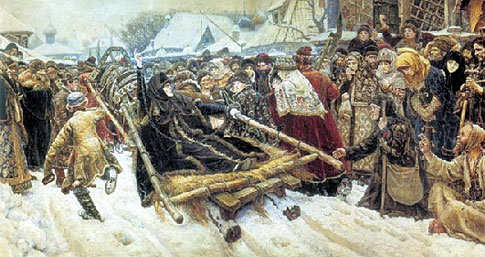“The Conspiracy of Claudius Civilis” by Rembrandt
 A prominent place in Rembrandt’s painting is taken by the painting “The Claudius Civilis Conspiracy”, created in 1661. This creation was destined to play a very special role in all Western European painting of the XVII century.
A prominent place in Rembrandt’s painting is taken by the painting “The Claudius Civilis Conspiracy”, created in 1661. This creation was destined to play a very special role in all Western European painting of the XVII century.
A number of reasons contributed to this. First of all, the unusualness of the task that arose before the artist. Rembrandt, whose activities developed in the field of easel paintings, by the conditions of the order was put before the need to create a work of monumental painting. The giant canvas was intended to decorate the Great Gallery of the Amsterdam City Hall – a magnificent structure, personifying the power and wealth of the Republic of the United Provinces. Far enough from the accepted themes in European historical painting was the plot of the picture proposed by the largest Dutch poet Jan Vondel. The call of Claudius Civilis, the leader of the Batavian tribe, to revolt against Rome resurrected an episode from the heroic past of the Dutch people and was perceived as a direct analogy to the liberation struggle of the Netherlands against the Spanish yoke.
In the development of the plot side, Rembrandt used a vivid story by the Roman historian Tacitus about how Civilis, under the pretext of feast, called into the sacred grove “the main representatives of his tribe and the greatest daredevils from the common people” and called them to revolt. He chose an oath episode for the picture, the climax of the narrative, in which the intensity of dramatic action found the most concentrated form of expression. The moment is presented when the participants of the conspiracy gathered around the banquet table, crossing their swords, utter the words of a solemn vow.
Since the picture was not preserved in its original form, for proper evaluation we must conduct its mental reconstruction based on the sketch that has come down to us.
The dimensions and outlines of the canvas (square 550×550 cm with a rounded top) were determined by the space intended for it in the arched frame at a five-meter height. Rembrandt with full responsibility approached the task of linking the picture with the real architecture surrounding it. To this end, he introduced monumental architectural motifs into the composition: the action takes place in the likeness of a temple room, in which the horizontal steps are stepped with the main group of characters, as well as the lines of arches and arched openings in the walls echo the outlines of the gallery. A clear compositional construction is supported by the placement of characters in three symmetrical groups with a raised center. These signs indicate that in its decision the Dutch master learned a lot from the lessons of the monumental wall painting of the Italian Renaissance and, in particular, the Raphael Stanz. But the motives that go back to the Renaissance classics turned out to be transformed into the crucible of Rembrandt art – in the unvarnished truth and in the expressive sharpening of the appearance of the action participants, in the condensed drama of the situation, in the vastness of the emotional space of the picture and in the triumph of the principles of tonal painting. And last but not least, Rembrandt used chiaroscuro dramaturgy as an organizing force in figurative and compositional terms. The light source here is unusual – it is the light from the plane of the table, behind which Civilis and his associates are placed (the lamps on the table are obscured by dark silhouettes of figures). This blindingly luminous horizontal, compositionally uniting the central group of characters, simultaneously concentrates the heat of tension ready to break through. The conspirators’ figures are only partially illuminated from below, so that their faces turn out to be in a reflex, a motive that intensifies the atmosphere of mystery and pre-storm tension.
Evaluating the imaginative qualities of the “Plot of Civilis”, we must take into account the time of its writing – 1661. The late period of Rembrandt was the time of creation of works with a few actors, described with deep intimate and psychological insight. Far from idle is the question: was Rembrandt able to successfully solve the problem of creating monumental heroic canvases with a large number of participants united into a single whole by a powerful will to action? The result achieved completely eliminates such doubts. The spectator is conquered by the gigantic scale of the plan, the artist’s courage in implementing the new theme, in affirming the unshakable determination of the participants in the uprising, shown to the degree of spiritual mobilization when the will impulse of everyone merges together with the general spiritual impulse ).
Another equally important find is the image of the main character, completely new and unusual for Rembrandt.



